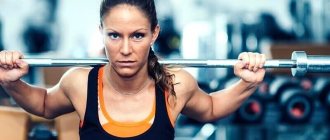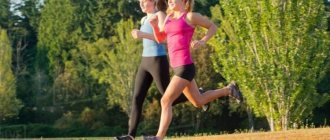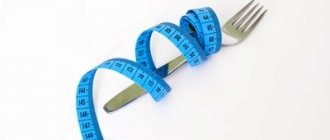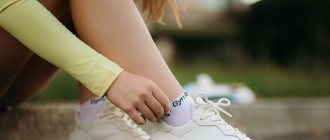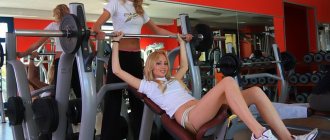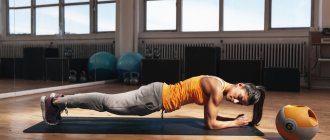Running is one of the most accessible types of physical activity. Minimum equipment, maximum capabilities.
You can go for a run near your house in a park or square, at a stadium, on a treadmill at home or in a fitness club, along the embankment of the resort where you are relaxing.
A variety of training modes: from the easiest jog to intense intervals. This makes running an effective exercise for people with any level of physical fitness.
Clear coordination of movements: everyone who can walk can run (with the exception of health contraindications, of course).
So far, there are more men than women among runners. But the interest of the fair half of humanity in this type of activity is growing every year.
We have prepared this article specifically for women who want to start running. There are a number of nuances, taking into account which you can make running your favorite tool for maintaining good athletic shape for many years. Or even become a reason to be proud of yourself - you can set specific goals for yourself in kilometers and/or minutes and achieve these results.
Let's tell you everything in order!
Motivation. Why run?
It’s worth starting your classes by answering this question. Take 15-20 minutes for yourself and reflect. It is best to write down the answers to the questions on a piece of paper or in your phone notes:
- Why do you want to run?
- What do you want to get from this lesson, what is your goal?
- How much time per week are you willing to devote to training?
- Will you train on your own or with a trainer?
- Where will you run?
Understanding your key motivation and desired conditions of activity will help you build a process so that this activity will bring the desired results, and not undesirable consequences.
Most often they run to:
Lose weight
Cardio exercise triggers the acceleration of metabolic processes in the body. This leads to more active “burning” of calories.
Improve and tone the cardiovascular system
If you notice that climbing stairs causes you to feel short of breath, then this is a signal from your body that your heart, blood vessels and lungs are in a weakened state. A healthy person can climb the 4th-6th floor at a normal pace without shortness of breath. If your performance on this simple test is worse, then there is a reason to start doing cardio exercises.
Relieve psychological stress
Running at a comfortable pace or brisk walking for 20 minutes or more triggers processes in the body that relieve nervous tension.
It may seem that after a busy day at work you no longer have the strength to do anything. But in fact, switching from mental to moderate physical work “reboots” the body. Blood actively moves throughout the body, body muscles become toned, endorphins are produced - “hormones of joy”.
Running is rightfully considered dynamic meditation. Many people note that while jogging, their thoughts become clearer and brilliant solutions come to even difficult life issues.
Be in the company of active healthy people
Nowadays people run for whom it is important to maintain health, a harmonious psychological state and fitness. They understand that moderate exercise makes a significant contribution to their quality of life for many years to come.
Participate in sporting events
The running movement covers all of Russia and the CIS. There are also foreign races - already in almost all countries of the world.
At the races, the organizers provide participants with a prepared route, timing of results, memorable souvenirs, and most importantly, at such competitions you will meet hundreds and thousands of like-minded people who are passionate about running.
This is a real holiday of health and sports, in which the majority of participants are ordinary people, lovers of running.
By the way, if you are an athlete actively involved in sports, if you are an amateur who regularly participates in competitions, then we have special discount cards for you that allow you to receive significant discounts on the equipment, shoes or clothing you need.
Goals for the race can be set as follows:
Participation: the task is to cover the distance without breaking a step (no matter how long it takes).
Result: the task of running a distance in a certain time is already for more prepared people.
The benefits of running
Although we know that it is better to consider any issue from all sides, we are always in favor of focusing on the positive aspects. If we talk about running, there are many positive aspects here. Here are five positive benefits of running that we've discovered.
1. Strengthens the cardiovascular system
The number one reason many people engage in this type of physical activity is because they want to improve their cardiovascular health. And it makes sense: running actually improves heart health.
Running strengthens your heart and cardiovascular system in general and increases your VO2 max.
2. Burns calories
It's no secret that running is a good exercise for burning calories. If you want to lose weight, keep your figure in check, or simply want to find an activity that will help you maintain a certain percentage of body fat, then running is the sport that can help you achieve these goals.
3. Strengthens joints
A lot is written and spoken about the topic of injuries and the possibility of preventing them, especially when it comes to running. But did you know that as long as you run in the right running shoes that provide proper foot strike and cushioning, running will actually help strengthen your bones and joints?
For those new to the sport, it is important to increase your distance and running activity gradually, week by week, as putting too much stress on your body can make injury more likely. However, if you increase the load gradually and run in good, carefully selected running shoes, you can significantly improve the health of your joints through running.
4. Works the lower body
It happens naturally. If you're looking for a lower body workout that includes cardio, start running—if you haven't run uphill yet, you're missing out! The day after running uphill, you will feel how actively your legs worked - delayed onset muscle soreness syndrome will not be long in coming.
Core activation is important for proper running technique, which means running also affects your upper body. And if you do specific arm exercises while running on hills, you'll get a full-body workout.
5. Provides time for reflection
If you haven't started running yet, this is a reason worth starting.
Exercise releases endorphins, and running is no exception! Endorphins are known to improve mood and help overcome stress. In addition, while running you get personal space, the opportunity to think about a question or reflect. You might be thinking about your long-term plans or plans for the day ahead—whatever it is, running is the perfect time to think and make decisions.
How to start running?
To start running, of course, first of all you need to choose sneakers that suit you according to your anatomical features, running technique, and which, of course, you like in design... and go outside. We advise you not to get attached to Monday or any calendar date. Just decide and do it!
All running shoes for women at Kant
Start with active walking. Pay attention to the position of the body: the arms work in opposition to the legs, the neck (and the rest of the body) is relaxed, the abs are toned, the body is slightly tilted forward, the feet land gently on the ground, rolling from the middle part of the foot to the toe.
Move like this for 4-5 minutes so that the body begins to warm up. When you feel warm in your body, you can move on to joint exercises and light muscle stretching. This warm-up is a necessary stage of training if you want to maintain and improve your health, and not harm yourself.
Think over the route so that you can walk actively or lightly to a convenient place or sports ground where you can warm up.
Do joint exercises: roll all the main joints (ankles, knees, hips, shoulders, elbows), do gentle tilts of the head to stretch the neck, and gentle tilts of the body to stretch the back and waist area, the stomach. Next, do 10 squats. You're ready to go for a run. Warm-up should take no more than 5 minutes so that the body does not “cool down”.
Then the main part of the training begins. For beginner runners, this should be 20-25 minutes of light jogging or active walking.
It is most convenient to focus on your pulse to assess the degree of stress your body is experiencing.
To do this, it is convenient to use a special sports watch with a heart rate tracking function.
Choose a sports watch that tracks your heart rate.
The pulse should be no more than 120 beats per minute.
If you don’t have a heart rate monitor, then you can focus on breathing: when the sensation of breathing is in the chest at the level of the solar plexus or slightly higher, the load is optimal. If the feeling of breathing becomes heavy and rises to the throat, the load is high. In this case, you need to slow down your running speed or switch to an active step. There is no need to stop suddenly - a sudden drop in speed puts a lot of stress on the heart.
Here we want to point out the most important thing - run at a pace where you feel comfortable running and don’t have the thoughts “Never again!” Brisk walking is a good alternative to running.
Finish your workout with an active step when your breathing becomes easy again. Be sure to stretch your leg muscles: standing on straight legs, bend forward (pull the back of your legs); lunge to the side (pull the inner surface of your legs); standing on one leg, bend the other leg at the knee (pull the front surface of the bent leg).
A good video on stretching after running can be seen here.
Stretching muscles after exercise is the key to healthy ligaments and joints, which recover and rest only if the muscles that worked during the workout are sufficiently relaxed.
How to run correctly
A few rules:
- Give your body an hour after waking up to prepare for physical activity. During this time, you can do hygiene procedures, have a light snack, and walk to the stadium at a leisurely pace.
- Create a running schedule.
- Each time, start with a warm-up (at least 15-20 minutes), and end with a cool-down. The last exercises should be done gradually reducing the load on the heart.
- Choose a place away from roads with fresh air.
- Breathe correctly. Inhale through your nose, it should be short. Exhale – twice as long, through the mouth.
Recommendations for women
Refrain from intense training during menstrual periods. Movement can lead to uterine bleeding and increased pain. Running is also prohibited for pregnant women and immediately after childbirth.
Pay more attention to your breathing; it is more difficult for girls to keep it in a certain rhythm than for guys. If your goal is to burn excess fat, then you should move slowly but for a long time.
Rules for a man
The stronger sex has a high risk of developing flat feet if the movements are performed incorrectly. The weight of the body should be distributed evenly over the entire foot using a roll - from landing on the heel to a smooth transition to the toe. The second tip is to choose shoes with good shock absorption and orthopedic insoles. Running in the morning is good, but only in good running shoes. Sneakers are absolutely unsuitable for this.
Another recommendation - if you want to have sculpted muscles and not lose weight, then limit yourself to 20-30 minutes, but give it your all.
Men have a harder time with leg injuries, especially muscle strains, so don't skip the warm-up.
Three Keys to Keeping Your Desire to Run
A) Regularity
The optimal amount of training for a beginner: 3-4 times a week - maximum. For example, running on Monday, Wednesday, Friday and/or Saturday. On other days, rest or light exercises to strengthen the abs (torso crunches and/or planks) and legs (squats, lunges). This will enable the body to recover well physically and emotionally and adjust to a uniform rhythm of work and rest.
If your life schedule is fluid, then train according to the following principles: the break between workouts should be at least a day and no more than three; It’s better to run twice every week than to run four times in one week and then do nothing at all for two weeks.
B) Gradual increase in load
Many people started running and quit after two weeks. Most of them neglected the golden rule of all training: you need to start with a small load, which your body will perceive as joy, and not as stress and punishment.
Intense walking is a good alternative to slow running if it is still difficult for you. Or if you are overweight (more than 10 extra kilos).
Remember that it is not the cool runner who immediately ran fast and a lot, and then did not go out for a second run due to muscle pain, shortness of breath and the shock of the nervous system from such a “sport”. Cool is the one who started small. If the last time you ran was at school/college, or if more than a month has passed since your last run, then start with walking training.
Walk one stop to transport or leave the car a little further from the office and take a walk.
For the first week or two, just walk at a normal pace. It is better to take two 10-minute walks a day than to run a kilometer in 6 minutes in one run.
Then move to a faster pace. With each workout, you can increase the distance covered by 100-200 meters. You will notice that these workouts are easy. There is no resistance to going outside just to take a walk.
If you are ready to jog a little, then start alternating between walking and slow running:
Run slowly for 1 minute (pulse up to 120-140 beats per minute).
Then walk actively for 3 minutes, helping yourself with your hands (pulse should drop to 100-110 beats).
Repeat this so many times to feel warmth in your body, but not experience severe discomfort.
This regime gives the heart, blood vessels and lungs a moderate load, protects the joints, and does not overload the nerves - training occurs at an acceptable level of load.
The gradual increase in load is extremely important for the health of the immune system: the body needs to adapt to a new rhythm of work, because when we move at a higher speed than usual, all systems of the body need to readjust to a new regime. This is beneficial for the body only if the load increases smoothly and gradually. It is also necessary to do training regularly, as we wrote above. After long breaks, you will need to start from the beginning - with walking.
Then you can gradually increase the duration of the running segments and reduce the duration of walking. If you practice regularly, you will feel progress: breathing will become easier, the body will adapt to the alternating speed of movement. You will want to increase your overall training duration. You can increase the total number of minutes by 10% each week.
If the word running gives you a feeling of heaviness, pain and suffering, then you are running too fast. Slow down or walk briskly at a speed that makes the workout enjoyable.
With this approach, the issue of motivation to train will be automatically resolved. We all love to do what makes us happy.
B) Conscious plan
Think ahead and imagine:
- What days of the week will you train? What can affect the transfer of training? It’s best to put workouts on your calendar - this way there’s less risk of missing them due to other important things.
- Where will you train? Outdoors or indoors? What kind of surface will you be running on?
- The answers to these questions will determine what equipment you will need to prepare for your workout.
For example, running on asphalt will require sneakers with more pronounced cushioning than running on a dirt track or treadmill belt.
"Women's" sneakers for running on asphalt
"Women's" sneakers for running on dirt
"Women's" treadmill running shoes
For indoor activities (where it can be hot and stuffy), you need a light running uniform:
- Top/sports bra
- T-shirt
- Lightweight shorts/breeches.
Running outside, especially in windy, rainy and cool weather, usually requires adding:
- jackets
- warmer trousers
- or tights
- or even thermal underwear.
If you run outside of where you live, you will most likely need a convenient bag to store and transport your uniform and sneakers.
Nordic walking - what is it?
Ershova Svetlana Yurievna Physiotherapist,
More about the doctor
Physical inactivity in old age can cause the development of chronic diseases and aggravate existing ones. To strengthen the heart muscle, increase the tone of skeletal muscles, increase bone density, saturate the body with oxygen, increase the functionality of the central nervous system, brain, and musculoskeletal system, experts recommend that elderly and senile people engage in accessible sports daily.
Nordic walking and its advantages over other types of activity
The most common physical activity for older people in urban environments is walking. Walking affects not only the physical condition of the body, but also normalizes the emotional background. Recently, a type of active pastime such as Nordic walking – walking with special poles in hands – has been gaining popularity.
When performing the Nordic walking technique correctly, a person uses about 90% of the core muscles, both in the lower and upper parts. And the average pace of the walk will not allow even a beginner to become overtired. The undeniable advantages include the low cost of equipment for this sport. All you need is comfortable shoes and training poles. The effectiveness of Nordic walking compared to conventional walking is 40-50% higher, as is its safety for older people.
The benefits of Nordic walking
The advantages of such a pastime include:
- moderate load on the cardiovascular and respiratory system - even a history of heart attacks Although the heart increases heart rate and cardiac output during exercise, it does not overwork. Accelerated blood flow better saturates the body with oxygen, neither the brain nor the heart experiences hypoxia;
- relief of joint condition - using poles when walking removes some of the load from the joints of the limbs, while increasing their functionality due to improved trophism. As a result, inflammation, pain, swelling decreases;
- weight normalization;
- normalization of the gastrointestinal tract, prevention of constipation;
- improving the sense of balance without the risk of falls and injuries - the use of 4 points of support instead of two allows even people with vestibular disorders to maintain balance when walking;
- increasing brain trophism serves as a prevention of strokes and senile dementia ;
- strengthening the immune system and improving the psycho-emotional state.
Execution technique, basic rules of Nordic walking
The comfort of classes and the benefits from them directly depend on the choice of equipment. The poles must be suitable for height, be light, and have additional removable tips for different types of road surfaces (asphalt, soil, sand). The length of the stick should be chosen so that when leaning on the stick in front, the elbow joint bends at an angle of 900. Clothes for exercise should be light and not hamper movement. Shoes are sports, with shock-absorbing soles. The ideal option is running sneakers.
Before you start walking, a short warm-up is necessary. After it, you can start walking at a low pace. The steps are light, springy, wide. With each step, the body rotates slightly by inertia after pushing off with a stick placed behind the back. The main emphasis is on the stick in front. The arm going behind the back should be completely straight, the palm should be unclenched, the stick is held on a belt worn on the wrist. Straightening the arm helps relieve tension from the shoulder joint and cervical spine. The duration of training ranges from 30 minutes to an hour.
Regular daily Nordic walking sessions will help older people keep their bodies in good shape, improve their well-being and improve their quality of life.
What muscles are involved in running?
The main muscles that need to work when running are the thighs (especially the inner surface) and the abs. What is the essence of their work: for the listed muscle groups, the main task when running (as well as when walking) is to maintain body balance. After all, when we run, we are constantly balancing from one foot to the other.
It is the abs and inner thigh that are closest to the center of gravity of the body; they are the easiest to keep the body in balance.
Please note that if your shoulders and calves are very tense when running, it means your abs and inner thighs are not engaged enough in the work. And this is a reason to strengthen them so that the muscles have enough strength to keep your body balanced while running.
Why do my knees hurt?
This is the most popular question among those who start running. Let's highlight a few points here.
A) Firstly, slight discomfort in the knees (as in other joints of the body) is a natural phenomenon. In normal life, joints and ligaments work less intensely than when running. When the speed of our movement increases and shock load is added, it is natural that the body organs need to adapt to the new level of load. The same two basic principles work here: regularity of classes and a gradual increase in load. If you start with small runs at an easy pace, then the joints, like all other organs and systems of the body, will be able to gradually adapt. The function trains the organ. If you move, the organs involved in the movement become stronger.
The main thing: the unpleasant sensation should not cause you much discomfort and in no case should it progress.
B) Secondly, we will tell you in general about the main causes of knee pain. Often in the course of life, people have overstrained the muscles of the anterior thigh (quadriceps). This causes the ligaments that attach the quadriceps to the knee joint to be in tension: they are tightly connected to the tense muscle and cannot relax until the muscle relaxes. And if the tension is not relieved for a long time, it causes inflammation of the ligament and, accordingly, pain.
We mentioned above that excessive strain on the calf muscles is undesirable. It can also negatively affect the sensations in the knee, because... The calf muscles are also attached by ligaments to the knee joint.
What to do? It is necessary to warm up the muscles before training so that not “cold” but warmed muscles begin to work. It is also extremely important to relax the muscles after exercise: do good stretching and give the muscles enough rest so that they have time to recover. Massages (from a specialist or self-massage) and hot baths help a lot.
It is also important to strengthen the muscles of the buttocks: good tone in this area “unloads” the quadriceps, taking part of the load on itself. It's functional and beautiful :) Pay attention to the relaxation of your feet. Special rollers and balls are affordable gadgets that will make your feet feel great.
Videos in which a sports doctor talks about the causes of knee pain and ways to relieve pain can be seen here, as well as in this video:
We encourage you to be attentive to your health. If you have questions about the presence of contraindications, it is best to ask them to sports doctors who work in medical institutions focused on working with athletes. These specialists work to ensure that people recover well from injuries and continue to play sports for as long as possible, with the greatest health benefits. They will give recommendations (and, if necessary, treatment) for a speedy recovery, and will not advise you to “lie down on the couch.”
How to run to lose weight
After your first attempts to lose weight by running, you don’t need to immediately expect results. Often training is exhausting, but does not bring the desired result. It is worth knowing that 20 minute sessions are not enough to start the fat burning process. Active burning can only be achieved through 40 minutes of continuous running. Then the body will not only use the glycogen accumulated in the liver (fuel for the first 40 minutes), but will also turn to fat deposits. At the same time, a high metabolism will remain for five hours after training, which means that you will lose weight even after completing the workout!
Running in the morning is more effective for weight loss, since a calorie deficit on an empty stomach triggers the fat burning process. Running in the evening is also good. By increasing your heart rate, you will get rid of daytime worries. Don't delay your evening workout and finish it 2-3 hours before going to bed.
Remember that running for more than 70 minutes may lead to muscle loss rather than fat loss. This is caused by a rapid decrease in muscle glycogen stores during prolonged exercise.
It is correct to start training with small runs, gradually increasing the time and distance. Breathing while running should be uniform and not intermittent. The pace of your run should be such that you can run and comfortably talk to someone next to you.
Everyone wants to look great on the beach in summer. But we advise you not to solve problems as they arise, but to engage in physical activity regularly. This will allow you to have a good figure, but most importantly, a healthy body always, and not just when you need to wear shorts or a swimsuit.
How is women's running different from men's?
Perhaps there are only two obvious differences between women's and men's running.
Women have less muscle mass and lower levels of testosterone in the blood than men. This means that women's running speed will be lower.
If you are training in a group where there are men, and you are a gambler, then do not be discouraged if you cannot catch up with your partners in speed. At the same time, women, as a rule, are more resilient than men and, on average, can run leisurely longer distances.
The second difference is this: the fair half of humanity is called the “weaker sex” due to the structural features of the pelvic muscles of the female body. We recommend that women pay attention to strengthening these muscles. This will help avoid discomfort during running loads and at the same time improve the condition of the internal organs.
Useful exercises can be seen in this video:
As you understand, anatomical features are not a reason not to engage in your favorite activity. Approach the issue comprehensively and thoughtfully - this is the key to health and improved body condition.
The main benefits of running in the morning
Running or brisk walking works no worse than dieting. By jogging daily, you can get rid of cellulite , tighten the muscles of the abdomen, thighs, and buttocks. Running allows you to remove salts from the body, which has a good effect on the functioning of your joints.
While running, the body is saturated with oxygen, breathing becomes deeper . Running can have a positive effect on female beauty. After running, your face becomes fresh and youthful.
Running is a natural massager for all internal female organs. During training , the fat that envelops them is burned At the same time, the body is cleansed and rejuvenated.
Running is a natural massager for all internal female organs
Interval running is the best way to lose weight
Running has the best effect on the cardiovascular and respiratory systems. By loading her heart, a woman is able to become strong and resilient, which will allow her to easily withstand life's difficulties.
While jogging, a fairly large number of calories . Therefore, running is good for losing weight. But to lose weight, you need to run slowly and longer to melt away unnecessary deposits.
Running has a positive effect on mental state . It is an excellent remedy for combating melancholy, despondency, and depression. Morning running gives positive emotions and a good mood, as well as a boost of energy for the whole day.
Running helps to defeat diseases and delay old age . This type of training cleanses and strengthens the body, gives youth.
Running can improve digestion and sleep . It develops will, character, determination - qualities that are so necessary for the fairer sex.
Running has a positive effect on blood circulation . During training, the production of hemoglobin, red blood cells, and leukocytes increases, which has a beneficial effect on the functioning of the immune system.
A woman who regularly jogs in the morning is less likely to suffer from colds and stress.
Lung volume increases.
What happens to the body while running
Equipment
Honestly, it doesn't matter what gear you have to start running. Just put on some athletic shoes and loose clothing and get started.
Between “run in sportswear that you already have” or “wait until a complete set is purchased,” choose the first. Once you start exercising, you will better understand the characteristics of your body and quickly select the equipment that suits you.
https://www.kant.ru/catalog/product/2784251/ https://www.kant.ru/catalog/product/3007547/ https://www.kant.ru/catalog/product/1791385/
After some time spent running, reading special articles, talking with more experienced runners or professional salespeople in sports stores, you will gradually figure out what exactly suits you best?
A competent consultant will ask you about the intensity of your training, the type of surface on which you run, measure the pronation of your feet, and also offer several models to choose from. By trying them on and remembering how your feet feel when you run, you can choose the best pair for you.
After two or three runs in the sneakers that you have, but which were most likely bought unconsciously, you will understand how you feel. The main difference between the right running shoes is good shock absorption and a reinforced heel support area.
Women's sneakers with increased cushioning
Check out our special article “The Best Asphalt Shoes for the Start of the Season.” How to make the right choice? there, it talks about sneakers with additional cushioning.
Women's sneakers differ from men's in several ways:
- The colors used are brighter and, as a rule, there are several design options for one model.
- The weight of the sneaker is less: since women weigh less on average than men, less shock-absorbing material is needed. Due to this, the sneaker itself is lighter.
- Narrower last: Women's feet are narrower. In this case, the front part of the last is wider than the heel part.
- In the heel area, the distance from the insole to the top of the sneaker is smaller: for women, the distance from the sole to the ankle is less than for men.
- The size range is limited to sizes 41-42.
You can read more about running shoes in our articles:
- “Saucony 2021 Sneaker Collection Review”
- “Review of the Brooks 2021 sneaker collection. From asphalt to trail”
- Battle of the “carbons”: Saucony Endorphin Pro vs Brooks Hyperion Elite 2. Comparison of two American speed monsters
- Choosing the right supportive running shoes. Using the example of Saucony Guide 14 and Hurricane 23
- Selection of versatile sneakers. Using the example of Saucony Ride 14
- ASICS Spring/Summer 2021 Running Shoe Collection Review
- The right choice of sneakers for the off-season. Trail and trail running models with Gore-Tex
- Hoka One One - new items and legends of the 2021 season
- Sneakers with carbon fiber. Review of carbon rockets from Asics, Hoka, Saucony, Adidas and Brooks
- Review of the Saucony Endorphin collection. The same you, but faster!
- The best asphalt sneakers for the start of the season. How to make the right choice?
- Suunto sports watches. Important features and necessary functions
Full set of equipment
Manufacturers of sports equipment offer a wide range of clothing and accessories that are developed using high technology. Sports equipment is created and improved for the most effective and comfortable training.
Moisture-wicking and windproof fabrics - for maximum comfortable body thermoregulation. Reflective fabrics - for safety in the dark.
Eco-technologies – to take care of the environment.
Also, special equipment is created according to patterns that take into account the anatomy of the female body and the biomechanics of movements. In such equipment you will have a feeling of smoothness and consistency of movements. Bright colors create a cheerful mood and add motivation to go for a run.
General principles for selecting equipment:
According to weather
You should dress in a way that makes you feel comfortable. In cold weather: moisture wicking away from the body and wind protection, if necessary, an additional layer of insulation. Be sure to protect your forehead and ears, hands and ankles (joints do not like cold).
In warm weather: moisture wicking. Remember that if you are hot in your clothes, this will be an additional reason for your heart rate to increase. When it rains, it is very convenient to wear a cap or visor - raindrops will not interfere with your eyes and you will not squint.
To size
It is optimal to choose clothes that fit slightly loosely on your body. This guarantees comfortable movement. The only exception is underwear - it must fit tightly enough. Choose a top that suits your figure.
Taste
Your reflection in the mirror should please you - it inspires you :)
Basic principles of effective training
In order not to waste time and energy, you should learn a number of simple rules before going for a run.
- Don't train with force. To prevent jogging from becoming a torment, first try to prepare yourself mentally, find internal arguments within yourself, and create the right mood. Don’t immediately chase records; choose the load based on your level of training. If running is too hard at first, alternate running with walking.
- Start with a warm-up. Before the main workout, you can walk for a few minutes at a fast pace, then, to avoid injuries and sprains, stretch your neck, back, legs, and definitely ankle joints.
- Important parameters that need to be monitored during training are breathing and pulse. For beginners, the pace should be such that the heart rate does not exceed 130 beats per minute. At the same time, watch the rhythm of your breathing, inhale through your nose, exhale through your mouth. Compliance with this rule will make the training comfortable and prevent overwork.
- The longer and more even the load, the greater the benefits of running for a woman. The fact is that active fat burning begins only 20 minutes after the start of jogging. Therefore, try to distribute your strength so that the total duration of the workout is 30-40 minutes. During this time, the body will not only have time to spend about 300 Kcal, but will also continue to intensively spend them for several more hours.
Once you have developed the habit of regular jogging, you will be surprised that your usual laziness has disappeared, your energy is overflowing, and your self-esteem rises with every look in the mirror and every compliment you hear.
Alone or in company? With or without a coach?
Whether to run alone or in a group – each runner chooses for herself. Let's list the main pros and cons of each choice.
Run on your own
This is convenient when time for training is limited. In this case, you only need to adapt to your schedule.
Running in company
You can combine jogging with chatting with friends. At an easy pace that allows you to maintain a conversation, you can discuss all pressing issues. This, by the way, is a good indicator: if you can speak while running, it means your fitness is growing.
But in a group you will need to agree on the time and place of the run, so you are dependent on your partner. Although this also disciplines at the same time: it is more difficult to skip when a friend is waiting at the appointed hour.
Running without a coach
If you started training according to the recommendations from our article, then after about a month of regular training you will want to diversify the load. A lot of options can help here: standard programs in free applications on your phone or information about the principles of a training plan that can be found on the Internet. You can run “according to your mood”: as much as you want right now. However, as you understand, this approach cannot guarantee clear results and safety for health.
Running with a trainer
This option is for those who value efficiency. If you have a goal, then a trained specialist will be able to guide you to it in the shortest possible way. A coach is a person who has already gone from starting classes to achieving certain results; he has experienced difficulties and will tell you how to avoid them.
You can study by receiving a plan online, or you can study in person: in a group or individually.
By the way, if you work out with a coach, then you will probably want to go to training camps. About what it is, how to take part in them, see our special article “Training Camps. Where and why to go?”
If you decide to work with a trainer, we recommend training companies that are our partners, the quality of whose work we are confident in, that have the necessary level of expertise and have been working in the fitness market for a long time:
- World Class
- ProTrainer
- I Love Supersports
- S10.run
How running affects your muscles
Running can strengthen your lower body muscles, but this largely depends on the intensity and duration of your runs.
In one study, 12 rest-trained college students completed high-intensity interval training (HIIT), which involved 4 bouts of maximal effort for 4 minutes followed by 3 minutes of active rest.
After 10 weeks of HIIT training 3 times a week, they showed an increase in muscle fiber area of their quadriceps (located at the front of the thigh) by almost 11% compared to the control group.
Therefore, training such as sprinting can promote muscle growth.
Aerobic exercise, such as running, is thought to increase muscle size by suppressing proteins that interfere with muscle growth and reducing muscle protein breakdown (MPB).
On the other hand, long-distance running can significantly increase MPB and thus inhibit muscle growth.
For example, in a study of 30 recreational runners who ran 6, 2, 13, or 26.1 miles (10, 21, or 42 km), all groups experienced significant increases in markers of muscle damage.
Levels of these markers increased with distance and remained elevated even after 3 days.
These results indicate that high-intensity, short-duration running increases leg muscles, while long-distance running causes significant muscle damage, inhibiting muscle growth.
Conclusion: High-intensity, short-duration runs like sprinting can build muscle mass, while long-distance running can hinder it.
Nutrition
- Once you start exercising, your appetite will likely increase. This usually causes bewilderment: how can you lose weight and be slim if you constantly want to eat? We recommend adding more “complex carbohydrates” to your diet. These are whole grain products and cereals. They do not cause a spike in blood sugar levels, and therefore the feeling of fullness from such foods lasts longer.
But it is better to minimize refined sugar and flour or completely remove it from the diet.
- Pay attention to how your body feels during a run from this or that food: dairy products and fruits, some vegetables can cause discomfort. If you notice such patterns, then on the day of training, eliminate foods that lead to discomfort.
- Drink enough clean water. Water is just water, not tea/coffee/drinks. You can stick to the usual 2 liters of water per day, and if you sweat profusely during training, you can add one or two more glasses.
- A good solution for health would be to monitor the level of microelements in the blood: iron, potassium, magnesium, zinc. It is convenient to check these indicators during your annual preventive examination, just like the condition of your heart.
Several reasons to start jogging
The female body contains much more fat cells than the male body, nature decided so. Cardio training is the most effective way to get rid of subcutaneous fat.
Running is the most popular and accessible type of cardio exercise, which does not require special equipment, training or money. It is not without reason that even bodybuilders do not neglect jogging to so-called “dry” the body and obtain a clear relief.
Cardio training accelerates metabolism, improves water-fat metabolism, saturates the blood with oxygen necessary to activate the calorie burning process, while fat is removed from the most problematic areas: the abdomen, sides and thighs.
Don't put it off until tomorrow, START running today!
Running group “START” - from 0 to 5 km. per month
More details
Most often, a woman’s main fitness goal is to fight fat reserves, and not to increase muscle mass, so let’s leave hard training in the gym to the stronger sex. Light jogging allows you to use all muscle groups at the same time, tone your body, while your figure only becomes more graceful, and you don’t have to worry about growing biceps and heavier thighs.
In addition to effective weight loss, the benefits of running for women include preventing heart and vascular diseases, accelerating metabolism, slowing down the aging process, lowering cholesterol and blood sugar levels, and improving liver function. In addition, this will help develop willpower, not only physical, but also mental endurance. Running stimulates the production of endorphins - joy hormones, which improves mood and vitality.
Many workers in the intellectual sphere use evening jogging to relieve mental and nervous tension; it is often at this time that unexpected answers to questions that seemed insoluble in their usual environment come to mind.
Safety
When you have determined the goal of running, eliminated health contraindications, selected the ideal equipment, and even acquired the best training plan for you, then it seems that nothing else can interfere with jogging.
However, when talking about women's running, it is important to mention safety. These days there are more and more people running on the streets and in parks, but despite this, a running person can still cause a rather violent reaction from passers-by.
Women may face intrusive glances, comments directed at them, and perhaps even attempts at physical advances. This can be quite unpleasant. Try to ignore the comments and abstract yourself. Staying calm, keeping a calm face and moving on is the best course of action.
Choose the time and place for jogging depending on the area and city where you run. Agree with loved ones or friends to run with you if you feel some uncertainty about safety. Take your dog (if he is large enough) with you for a run.
In any case, remember that you can always actively call passers-by for help, run into the nearest cafe or store. Well, choose less bright equipment if you have concerns.
